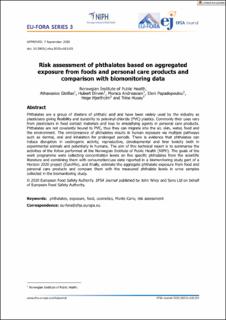Risk assessment of phthalates based on aggregated exposure from foods and personal care products and comparison with biomonitoring data
Gkrillas, Athanasios; Dirven, Hubert; Andreassen, Monica; Papadopoulou, Eleni Zoumpoulia; Hjertholm, Hege; Husøy, Trine
Peer reviewed, Journal article
Published version
Permanent lenke
https://hdl.handle.net/11250/2729253Utgivelsesdato
2020Metadata
Vis full innførselSamlinger
- Artikler [5061]
- Publikasjoner fra CRIStin FHI [7536]
Sammendrag
Phthalates are a group of diesters of phthalic acid and have been widely used by the industry asplasticisers givingflexibility and durability to polyvinyl chloride (PVC) plastics. Commonly their uses varyfrom plasticisers in food contact materials and toys to emulsifying agents in personal care products.Phthalates are not covalently bound to PVC, thus they can migrate into the air, skin, water, food andthe environment. The omnipresence of phthalates results in human exposure via multiple pathwayssuch as dermal, oral and inhalation for prolonged periods. There is evidence that phthalates caninduce disruption in oestrogenic activity, reproductive, developmental and liver toxicity both inexperimental animals and potentially in humans. The aim of this technical report is to summarise theactivities of the fellow performed at the Norwegian Institute of Public Health (NIPH). The goals of thework programme were collecting concentration levels onfive specific phthalates from the scientificliterature and combining them with consumption/use data reported in a biomonitoring study part of aHorizon 2020 project (EuroMix), andfinally, estimate the aggregate phthalate exposure from food andpersonal care products and compare them with the measured phthalate levels in urine samplescollected in the biomonitoring study.
